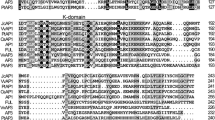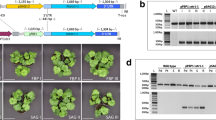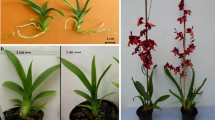Abstract
The genetic engineering of agronomic traits requires an array of highly specific and tightly regulated promoters that drive expression in floral tissues. In this study, we isolated and characterized two tobacco APETALA1-like (AP1-like) promoters (termed NtAP1La and NtAP1Lb1) in transgenic plants using the GUS reporter system, along with tissue-specific ablation analyses. Our results demonstrated that the two promoters are active in floral inflorescences but not in vegetative apical meristems or other vegetative tissues, as reflected by strong GUS staining and DT-A-mediated ablation of apical shoot tips during reproductive but not vegetative growth. We also showed that the NtAP1Lb1 promoter was more active than NtAP1La in inflorescences, as the former yielded higher frequencies and greater phenotypic evidence of tissue ablation compared to the latter. We further revealed that both promoters were uniformly expressed in the meristems of stage 1 and 2 floral buds, but were differentially expressed in floral organs later during development. While NtAP1La was found to be active in stage 4–5 carpels, later becoming confined to ovary tissue from stage 9 onwards, NtAP1Lb1 activity was apparent in all floral organs from stages 3 to 7, becoming completely absent in all floral organs from stage 11 onward. Therefore, it seems that the two tobacco promoters have acquired similar but distinct inflorescence-, floral meristem- and floral organ-specific and development-dependent regulatory features without any leaky activity in vegetative tissues. These features are novel and have rarely been observed in other flower-specific promoters characterized to date. The potential application of these promoters for engineering sterility, increasing biomass production and modifying flower architecture, as well as their putative use in flower-specific transgene excision, will be discussed.





Similar content being viewed by others
Abbreviations
- CsVMV :
-
Cassava vein mosaic virus promoter
- DT-A :
-
Diphtheria toxin A
- GUS :
-
β-Glucuronidase
- NtAP1L :
-
Nicotiana tabacum AP1-like
- PCR:
-
Polymerase chain reaction
- RT-PCR:
-
Reverse transcription polymerase chain reaction
- SAM:
-
Shoot apical meristem
References
Abe M, Kobayashi Y, Yamamoto S, Daimon Y, Yamaguchi A, Ikeda Y, Ichinoki H, Notaguchi M, Goto K, Araki T (2005) FD, a bZIP protein mediating signals from the floral pathway integrator FT at the shoot apex. Science 309:1052–1056
Atanassova R, Chaubet N, Gigot C (1992) A 126 bp fragment of a plant histone gene promoter confers preferential expression in meristems of transgenic Arabidopsis. Plant J 2:291–300
Chang WC, Lee TY, Huang HD, Huang HY, Pan RL (2008) PlantPAN: plant promoter analysis navigator, for identifying combinatorial cis-regulatory elements with distance constraint in plant gene groups. BMC Genom 26(9):561. doi:10.1186/1471-2164-9-561
Corbesier L, Vincent C, Jang S, Fornara F, Fan Q, Searle I, Giakountis A, Farrona S, Gissot L, Turnbull C, Coupland G (2007) FT protein movement contributes to long–distance signaling in floral induction of Arabidopsis. Science 316:1030–1033
Feldbrügge M, Sprenger M, Dinkelbach M, Yazaki K, Harter K, Weisshaar B (1994) Functional analysis of a light-responsive plant bZIP transcriptional regulator. Plant Cell 6:1607–1621
Gu Q, Ferrándiz C, Yanofsky MF, Martienssen R (1998) The FRUITFULL MADS-box gene mediates cell differentiation during Arabidopsis fruit development. Development 125:1509–1517
Gustafson–Brown C, Savidge B, Yanofsky MF (1994) Regulation of the Arabidopsis floral homeotic gene APETALA1. Cell 76:131–143
Hempel FD, Weigel D, Mandel MA, Ditta G, Zambryski PC, Feldman LJ, Yanofsky MF (1997) Floral determination and expression of floral regulatory genes in Arabidopsis. Development 124:3845–3853
Higo K, Ugawa Y, Iwamoto M, Korenaga T (1999) Plant cis-acting regulatory DNA elements (PLACE) database:1999. Nucleic Acids Res 27:297–300
Hong RL, Hamaguchi L, Busch MA, Weigel D (2003) Regulatory elements of the floral homeotic gene AGAMOUS identified by phylogenetic footprinting and shadowing. Plant Cell 15:1296–1309
Horsch RB, Fry JE, Hoffmann NL, Wallroth M, Eichholtz D, Rogers SG, Fraley RT (1985) A simple and general method for transferring genes into plants. Science 227:1229–1231
Immink RG, Hannapel DJ, Ferrario S, Busscher M, Franken J, Lookeren Campagne MM, Angenent GC (1999) A petunia MADS box gene involved in the transition from vegetative to reproductive development. Development 126:5117–5126
Jang S, Hong MY, Chung YY, An G (1999) Ectopic expression of tobacco MADS genes modulates flowering time and plant architecture. Mol Cells 9:576–586
Jang S, An K, Lee S, An G (2002) Characterization of tobacco MADS-box genes involved in floral initiation. Plant Cell Physiol 43:230–238
Kim SY, Wu R (1990) Multiple protein factors bind to a rice glutelin promoter region. Nucleic Acids Res 18:6845–8652
Kim JK, Cao J, Wu R (1992) Regulation and interaction of multiple protein factors with the proximal promoter regions of a rice high pI alpha-amylase gene. Mol Gen Genet 232:383–393
Kuhlemeier C, Fluhr R, Green PJ, Chua NH (1987) Sequences in the pea rbcS-3A gene have homology to constitutive mammalian enhancers but function as negative regulatory elements. Genes Dev 1:247–255
Lannenpaa M, Hassinen M, Ranki A, Holtta-Vuori M, Lemmetyinen J, Keinonen K, Sopanen T (2005) Prevention of flower development in birth and other plants using a BpFULL1:BARNASE construct. Plant Cell Rep 24:69–78
Lebrun M, Waksman G, Freyssinet G (1987) Nucleotide sequence of a gene encoding corn ribulose-1, 5-bisphosphate carboxylase/oxygenase small subunit (rbcs). Nucleic Acids Res 15:4360
Lee H, Suh S, Park E, Cho E, Ahn JH, Kim S, Lee JS, Kwon YM, Lee I (2000) The AGAMOUS-LIKE 20 MADS domain protein integrates floral inductive pathways in Arabidopsis. Genes Dev 14:2366–2376
Lemmetyinen J, Keinonen K, Sopanen T (2004) Prevention of the flowering of a tree, silver birch. Mol Breed 13:243–249
Lescot M, Déhais P, Thijs G, Marchal K, Moreau Y, Van de Peer Y, Rouzé P, Rombauts S (2002) PlantCARE, a database of plant cis-acting regulatory elements and a portal to tools for in silico analysis of promoter sequences. Nucleic Acids Res 30:325–327
Lin EP, Peng HZ, Jin QY, Deng MJ, Li T, Xiao XC, Hua XQ, Wang KH, Bian HW, Han N, Zhu MY (2009) Identification and characterization of two bamboo (Phyllostachys praecox) AP1/SQUA–like MADS–box genes during floral transition. Planta 231:109–120
Liu Z, Liu Z (2008) The second intron of AGAMOUS drives carpel- and stamen-specific expression sufficient to induce complete sterility in Arabidopsis. Plant Cell Rep 27:855–863
Liu C, Thong Z, Yu H (2009) Coming to bloom: the specification of floral meristems. Development 136:3379–3391
Lois R, Dietrich A, Hahlbrock K, Schulz W (1989) A phenylalanine ammonia-lyase gene from parsley: structure, regulation and identification of elicitor and light responsive cis-acting elements. EMBO J 8:1641–1648
Mandel MA, Yanofsky MF (1995) The Arabidopsis AGL8 MADS box gene is expressed in inflorescence meristems and is negatively regulated by APETALA1. Plant Cell 7:1763–1771
Mandel MA, Gustafson–Brown C, Savidge B, Yanofsky MF (1992) Molecular characterization of the Arabidopsis floral homeotic gene APETALA1. Nature 360(6401):273–277
Napoli CA, Beveridge CA, Snoden KC (1998) Reevaluating concepts of apical dominance and the control of axillary bud outgrowth. Curr Top Dev Biol 44:127–169
Nilsson O, Wu E, Wolfe DS, Weigel D (1998) Genetic ablation of flowers in transgenic Arabidopsis. Plant J 15:799–804
Palmiter RD, Behringer RR, Quaife CJ, Maxwell F, Maxwell IH, Brinster RL (1987) Cell lineage ablation in transgenic mice by cell-specific expression of a toxin gene. Cell 50:435–443
Peña L, Martín-Trillo M, Juárez J, Pina JA, Navarro L, Martínez-Zapater JM (2001) Constitutive expression of Arabidopsis LEAFY or APETALA1 genes in citrus reduces their generation time. Nat Biotechnol 19:263–267
Prestridge DS (1991) SIGNAL SCAN:a computer program that scans DNA sequences for eukaryotic transcriptional elements. Comput Appl Biosci 7:203–206
Sather DN, Golenberg EM (2009) Duplication of AP1 within the Spinacia oleracea L. AP1/FUL clade is followed by rapid amino acid and regulatory evolution. Planta 229:507–521
Shchennikova AV, Shulga OA, Immink R, Skryabin KG, Angenent GC (2004) Identification and characterization of four chrysanthemum MADS–box genes, belonging to the APETALA1/FRUITFULL and SEPALLATA3 subfamilies. Plant Physiol 134:1632–1641
Singer SR, McDaniel CN (1986) Floral determination in the terminal and axillary buds of Nicotiana tabacum L. Dev Biol 118:587–592
Srinivasan C, Dardick C, Callahan A, Scorza R (2012) Plum (Prunus domestica) trees transformed with poplar FT1 result in altered architecture, dormancy requirement, and continuous flowering. PLoS ONE 7:e40715. doi:10.1371/journal.pone.0040715
Sung SK, Yu GH, An G (1999) Characterization of MdMADS2, a member of the SQUAMOSA subfamily of genes in apple. Plant Physiol 120:969–978
Takaiwa F, Oono K, Kato A (1991) Analysis of the 5′ flanking region responsible for the endosperm-specific expression of a rice glutelin chimeric gene in transgenic tobacco. Plant Mol Biol 16:49–58
Tilly JJ, Allen DW, Jack T (1998) The CArG boxes in the promoter of the Arabidopsis floral organ identity gene APETALA3 mediate diverse regulatory effects. Development 125:1647–1657
Wang HZ, Hu B, Chen GP, Shi NN, Zhao Y, Yin QC, Liu JJ (2008) Application of Arabidopsis AGAMOUS second intron for the engineered ablation of flower development in transgenic tobacco. Plant Cell Rep 27:251–259
Wang XP, Singer SD, Liu Z (2012) Silencing of meiosis-critical gene for engineering male sterility in plants. Plant Cell Rep 31:747–756
Weigel D, Nilson O (1995) A developmental switch sufficient for flower initiation in diverse plants. Nature 377:495–550
Wellmer F, Riechmann JL (2010) Gene networks controlling the initiation of flower development. Trends Genet 26:519–527
Wigge PA, Kim MC, Jaeger KE, Busch W, Schmid M, Lohmann JU, Weigel D (2005) Integration of spatial and temporal information during floral induction in Arabidopsis. Science 309:1056–1059
Yang Y, Singer SD, Liu Z (2010) Two similar but distinct second intron fragments from tobacco AGAMOUS homologs confer identical floral organ-specific expression sufficient for generating complete sterility in plants. Planta 231:1159–1169
Yang Y, Singer SD, Liu Z (2011) Petunia AGAMOUS enhancer-derived chimeric promoters specify a carpel-, stamen-, and petal-specific expression pattern sufficient for engineering male and female Sterility in Tobacco. Plant Mol Biol Rep 29:162–170
Yu H, Goh CJ (2000) Identification and characterization of three orchid MADS-box genes of the AP1/AGL9 subfamily during floral transition. Plant Physiol 123:1325–1336
Zik M, Irish FV (2003) Flower development: induction, differentiation, and diversification. Annu Rev Cell Dev Biol 19:119–140
Acknowledgments
We thank Mr. Dennis Bennett for his excellent technical assistance. This study was funded by the USDA NIFA Biotechnology Risk Assessment Research grant (2009-01067).
Author information
Authors and Affiliations
Corresponding author
Additional information
J. Zhang and G. Yan contributed equally to this work.
The nucleotide sequencing data reported here have been deposited in the GenBank database under the accession numbers KF539844 (NtAP1La), KF530845 (NtAP1Lb1) and KF530846 (NtAP1Lb2).
Rights and permissions
About this article
Cite this article
Zhang, J., Yan, G., Wen, Z. et al. Two tobacco AP1-like gene promoters drive highly specific, tightly regulated and unique expression patterns during floral transition, initiation and development. Planta 239, 469–478 (2014). https://doi.org/10.1007/s00425-013-1995-9
Received:
Accepted:
Published:
Issue Date:
DOI: https://doi.org/10.1007/s00425-013-1995-9




